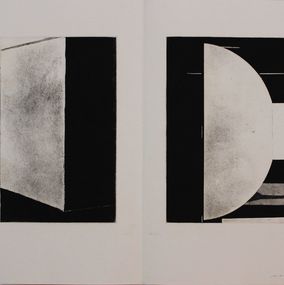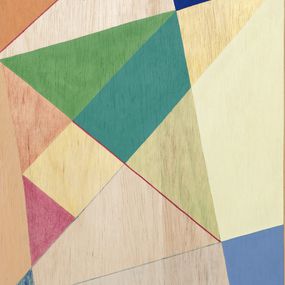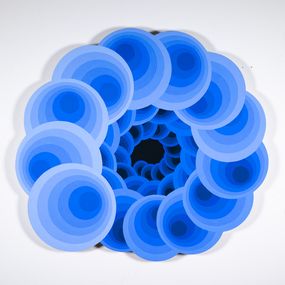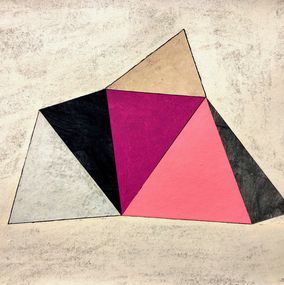





Print : Screen Print 70 x 70 cm 27.6 x 27.6 inch
One of the last works available by this artist
Free returns within 14 days
Authenticity guaranteed
Learn moreNumbered and limited to 100 copies
1 copy available
Hand-signed by artist
Sold with certificate of Authenticity from the gallery
Invoice from the gallery
About the seller
Professional art gallery • France
Artsper seller since 2015
Vetted Seller
This seller rewards your purchases of multiple artworks


Albert Jean Gorin, known as Jean Gorin, is a French artist, born in 1899 in Saint-Émilien-de-Blain and died in 1981 in Niort.
Mondrian said of Jean Gorin, thirty years his junior, that he was "the only French neoplastician". But if the latter never missed an opportunity to assert his debt to the Dutch master, today we can regret that the recognition of his work has suffered somewhat from this sponsorship. We must indeed distinguish between his first neoplastic canvases (1926), still very close to Mondrian's painting, and his first sculptures, his first reliefs of the years 1928-1930, which are among the most elegant contributions to the constructivist side of twentieth century art. Mondrian himself was not mistaken, who strongly encouraged Gorin to continue in this direction, going so far as to write to him, in a letter full of friendship, "it is beyond my work, which remains still "table" background ".
During a trip to Paris, he saw Cubist paintings for the first time; back in Brittany, he devours the book by Gleizes and Metzinger (Du cubisme), reading which is his road to Damascus. In 1925, at the Decorative Arts Exhibition, it is the meeting not only of the architecture of Le Corbusier, but also of his painting (purism) as well as that of Léger, two parallel approaches including his first abstract works. synthesize. In 1926, he discovered an issue of Vouloir, a small review in Lille, which contained an article by Mondrian and reproductions of his paintings. The same journal informed him of the research of Vantongerloo, with whom he immediately entered into correspondence, curious to know more about his differences with Mondrian as to the theory of colors.
Today it is difficult to imagine the working conditions of Jean Gorin at that time, which are heroism, and to imagine his absolute solitude. Forced, for economic reasons, to live far from Paris, enthusiastic about the little he knows about neoplasticism, he decides to visit Mondrian in 1927. This meeting will leave him with an indelible memory. Back in Nort-sur-Erdre, he modifies his studio to make it, like Mondrian's, a neo-plastic interior. He returned from his trip to Paris with the idea of an expansion in the space of pictorial neoplasticism and this is what founds the originality of his work. But much more than in architecture (he draws many projects that will not be realized), it is in sculpture that Jean Gorin explores the three-dimensional space.
His first sculpted works, unfortunately mostly destroyed, form one of the richest interpretations of neoplasticism: by the intersection of cantilevered rectangular planes, they fix the surrounding space by figuring its coordinates, thus generating an impression of perpetual oscillation between centripetal and centrifugal movements; moreover, the polychromy (still very rare at the time) accentuates this virtual kineticism by constantly tilting the planes into each other, accentuating their recession or their protrusion. Becoming more complex and more openwork during the 1930s and 1940s, Gorin's sculpture ended up abandoning the exclusive use of colored planes, adding to them that of lines in space, black or white. From 1950, his best sculptures consisted of a linear framework on which are fixed color planes that stretch towards the four cardinal points.
Although Gorin produced an important pictorial work (canvases and architectural projects constitute the main part of his first personal exhibition, in Nantes, in 1928), his other favorite field is the art of relief, which allows him to deal with in sculpture of pictorial problems. His first reliefs are hollow "paintings" (1930): the lines which separate the rectangles of the neoplastic composition are no longer black but white and in the shade, set back a few millimeters from the plane of the painting. Then he adds lines in relief, black or colored, which create a layering of the planes in depth, a laminate which becomes more and more complicated and thick (Composition spatio-temporelle no 9, 1934). Colored planes are then grafted onto these protruding lines: the relief gradually becomes a sculpture in its own right (some of these works can be seen in two ways: placed on the ground or fixed to the wall).
1928, Lille: Neoplastic works with the Stuca group
1929-1930: Exhibition with the Cercle et Carré group created by Michel Seuphor and Joaquín Torres García.
1930, Nantes: Invited by the artistic group L'Etrave
1931, Paris: Exhibition of his first relief in an exhibition of the 1940 group
1945, Paris: Concrete Art Exhibition, Galerie René Drouin.
1946: Salon des Réalités Nouvelles, of which he is the secretary
1948, New York: Constructive Abstract Art Exhibition
1957, Paris: 50 years of abstract painting organized at Galerie Creuze, first private exhibition at Galerie Colette Allendy
1958, Saint-Étienne: The first generations of abstract art
1960, Liège: Museum of Walloon Art
1965, Nantes: Retrospective (1921-1965) at the Museum of Fine Arts
1966, Chicago: Exhibition at the Kazimir Gallery
1967, Amsterdam: Retrospective at the Stedelijk Museum
1969, Paris: Retrospective at the National Center for Contemporary Art
1974, Paris: Exhibition at the Galerie Denise René
1977, Nantes: Retrospective at the Museum of Fine Arts
1977, Paris: Center Pompidou
1999, Blain: Homage of the Madi movement to Gorin, Château de la Groulais
1999, Grenoble: Jean Gorin exhibition.
How does Artsper protect you?
Protect your purchase
We’re here to help you collect art securely. When you browse and buy on Artsper, you benefit from our guaranteed protections.
Buy works from the best galleries
We partner with the best art galleries. All sellers on Artsper have been carefully reviewed and approved by our team. All of our partner galleries respect our code of ethics.
Know what you’re getting
Each work on Artsper is studied and validated by our team before appearing online. Get personalized support Contemporary art specialists are available by phone and email to answer all of your questions about our works of art. Get personalized advice and curated suggestions for your collection.
Resell your artworks
As a private individual, you have the possibility to resell on Artsper your works acquired on Artsper. For more information click here.
Make an offer with Artsper
Negotiate prices
Price negotiation is possible. Like in a gallery, this allows you to open a discussion and purchase your works at your preferred price.
Get our help negotiating
Let our team handle the negotiations and get back to you once the best deal is made.
Order safely
Artsper’s satisfaction guarantee
With Artsper, you have the opportunity to return a work free of charge within 14 days of receipt if it does not suit you, for whatever reason. You will then receive a full refund for your order.
Protect your purchase with Artsper’s payment partners
All credit card payments are processed by Paybox, the trusted leader in payment processing for international businesses. Paybox ensures the highest level of security.
Get specialized support from Artsper in the event of a problem
On the rare occasion that a work of art arrives in a different condition than described, we will work to administer a return, refund, restoration or exchange for you. Our team will always keep you informed on the progress of your request and will go above and beyond to offer you personalized solutions.
To benefit from Artsper’s protections you must:
Place your order using one of Artsper's payment methods.
Report any issues to Artsper within one week of receiving your work.
Provide all requested photographic evidence of the problem (including the original artwork and packaging).
Artsper’s guarantee covers the following problems:
You receive a work that’s missing a described characteristic (such as a signature or a frame)
You receive a work with different characteristics than those described at the time of purchase
You receive a damaged piece of work
Your purchase is declared lost or damaged during transit
You receive a work that is a different in color than what you ordered
Your purchase is delayed
Why buy on Artsper?
Artsper gives you access to the largest catalog of contemporary artworks, from the best galleries (200,000 works, 25,000 artists, 2,000 partner galleries).
We select the galleries with which we collaborate. This demanding selection, operated by our team of experts, offers you several guarantees:
We also facilitate the search for works according to your preferences thanks to our intelligent features such as:
Or simply thanks to our filters on the catalog allowing you to refine your searches.
Our customer service is also at your service and responds within the shortest time!
Can I negotiate the price of an artwork?
For some artworks, you can negotiate the price. If the price of the work is negotiable, you have a “Make an offer” button under the “Buy this work” one.
To submit your offer, you must make a payment of the desired amount. Your offer will then be forwarded to the gallery, which reserves the right to accept or reject it. If your offer is accepted, it means that your order is confirmed by the gallery and they will prepare the artwork for shipment. If your offer is rejected, you will be refunded the total amount paid automatically. The gallery can also propose a counter-offer for the acquisition of the artwork.
If you have any questions, please feel free to contact us: [email protected].
Where can I have my order delivered?
Artsper delivers worldwide!
However, please note that once your order reaches its destination, it may be subject to VAT or other customs fees. These charges are beyond our control and you will be responsible for paying them (this is indicated at the ‘checkout’ first step).
Select the delivery address of your choice. Please make sure that someone is present to receive your order.
If your billing address is different to your delivery address you can specify this at the checkout.
Return and cancellation
You can return the artwork without needing to provide a reason or pay a penalty fee up to 14 days after receiving your order.
In the case that the right of withdrawal is exercised in the aforementioned time frame, the price of the artwork(s) purchased and the shipping costs will be reimbursed by us as soon as the gallery has received the artwork and notified us.
Artsper will manage the return of the work and will bear the cost of returns (which will either be paid by you and refunded by Artsper or directly paid by Artsper).
The artwork must be returned in perfect condition and in its original packaging (or equivalent).
The buyer exercises his right of withdrawal directly from MUMART, by sending an email to the address: [email protected].
How can I best showcase my work?
If you have bought a painting, a sculpture or a work on paper, find expert advice on its conservation and how to best enhace it:





